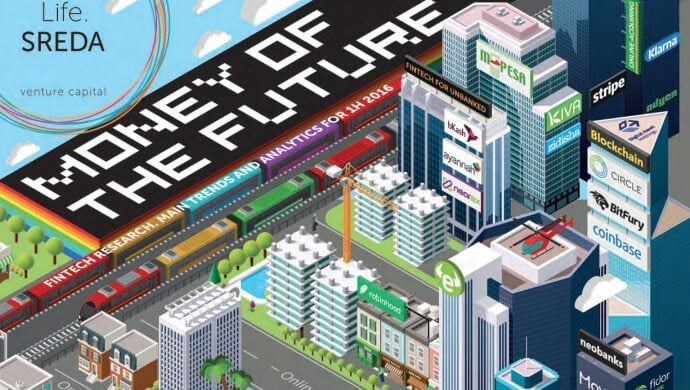Fintech companies have now started to partner among themselves in order to build an ecosystem

On Friday, the Singapore-based VC firm Life.SREDA released its bi-annual Money of the Future fintech report.
The 285-page report details the trends, projections and important companies across the entire fintech spectrum. It’s comprehensive, with a deep-dive into nearly every fintech vertical imaginable.
Life.SREDA is a particularly appropriate source for this kind of report, because the firm is entirely focussed on fintech, and Managing Partner Vladislav Solodkiy runs an information/aggregation portal for the industry.
Because the report is so broad and comprehensive, it would be nearly impossible to capture it in a 1,000-word article.
So, after reading the report, e27 interviewed Solodkiy via email about some of the thought-provoking ideas presented in ‘Money of the Future’.
The edited excerpts are below:
(For those interested in the report published in Chinese, Japanese and Korean, it can be found here).
I’m going to start with a silly question: Was the cover page inspired by the television show Silicon Valley?

No. We always pay a lot of attention to the design of our reports (and investor decks and presentations for partners as well).
Design for us is very important, not as ‘beautiful colourful pictures’.A good design has the ability:
- to explain smart, but sometimes difficult and boring ideas in the easiest way
- to inspire not only the pragmatical, but also the emotional part of our reader’s brains.
- to provide the passion, chemistry and dynamic of lifestyle of customers of fintech startups.
From issue to issue, we choose new design idea to disclose our ‘sense’ of fintech. Right now, the main trend is the start of the partnerships of fintech companies amongst themselves. And hence we zeroed in on ‘fintech city’; something close to Sim City, in terms of style.
Your top point is ‘the market doubles every year. It is neither good nor bad – it is normal’. It is a rather bearish statement. I would love to hear your reasoning.
There is a big hype around fintech. But there is also a lot of bullshit (as with any hype). And typical bullshit behaviour with hot topics is not to go deep in details and work hard, but to use loud titles with big numbers.
Now, it is very easy to understand the ‘who is who’ of fintech, because real experts talk about details (customisation of products to each market, new ways of monetisation, exit strategies, new verticals and names etc.).
Bullshit guys use the same ‘vocabulary for dummies’,
such as ‘fintech is disrupting financial industry’, ‘fintech attracted record high numbers of investments’, ‘P2P-lending’, ‘e-wallets’, ‘ApplePay’, ‘AliPay’, blah-blah-blah. Common words. When I am saying ‘volume doubles but who cares?’, I mean ‘stop please your dances with drums, what is the new thing you want to suggest or explain?’.
You don’t see a future for messaging system remittances (or at least in the next year or so). Why?
No, no, no! I am waiting for this future. And not only me, but many experts, but [so far] it has only happened for WeChat.
Also Read: Ayannah raises US$1M Series A funding from 500 Startups and Life.SREDA
Others are still out of the game — most [players] have solutions, but do not have usage volume and value for customers. Maybe, it is because all messengers have tried to do it by themselves. So maybe, we will buy better third-party solution on the market. Maybe, with chatbots we will see the real usage… But still, everybody is waiting.
With regard to businesses using crowdfunding platform to raise money, you wrote,”while online lending was primarily focused on retail customers previously, today the maximum number of new players are thinking in terms of small and medium business loans”. Do you mind elaborating?
It is normal evolution — all of us are retail customers (Facebook, WhatsApp, Instagram, Twitter) and some of us are entrepreneurs or businesses (LinkedIn, Slack).
To launch something for retail customers, it is easier to attract attention. And when we start talking about ‘businesses’, most of us will imagine big corporates.
But SMEs are underestimated and booming now (WeWork, sharing economy, gig-economy, etc). And they are as clients extremely underserved by banks. Banks historically paid attention to retail and corporate clients, not to SMEs.
Do you mind elaborating a bit on the bank-as-a-service idea? Just give the readers an idea of the type of products this might reference.
Before Amazon Web Services (AWS), entrepreneurs had to buy new servers, new software and hire IT supporters to scale with their online startup. Now they do not need to buy or hire anybody; they just use the pay-per-use model of AWS.
BaaS (bank-as-a-service) is the same. Instead of buying banking/financial licences, processing centres, card-issuing centres, compliance services, etc., startups can easily rent it, and launch and scale with the service much faster, easier, better and cheaper than before.
[The trend] is very necessary for Asia. Banks can’t serve fintech because the infrastructure does not exist. Therefore, most of fintechs will die soon if situation does not change.
You seem to think, to a certain degree, that outside of the US fintech is going to collaborate with banks, rather than antagonise and take them on. Is this fair?
Only one question: Do they want to do it? Or must they do it?
I am not sure whether they are happy with this ‘collaboration’.
Regulators are always trying to support banks and push fintechs to work with banks. Not vice versa. They are not pushing banks to change, learn from fintechs, etc.
I am not sure that strategy is useful for banks, fintechs… but it is very useful for US-based fintech firms, because when they come to any local market they will compete with local fintechs and banks very successfully.
You give a nice overview of the mobile banking industry in Asia but refrain from making an opinion (probably good in a report). But I’m curious, do you think mobile wallets will get significance over the next five years? Or is it a cool feature for tech and finance geeks but might not expand to the general public?
Yes, this game has just started, and these players are extremely big (Internet giants, smarphone manufactures, social networks). Everything we see today is just the baby steps. But the battle has not started yet. It is just preparation for the war.
What is your personal favourite fintech trend? Why?
That fintech companies have started to partner among themselves in order to build an ecosystem. If a previous exit strategy looked like ‘your startup will be acquired by a bank’ we can create the big bank.
Why hasn’t online remittances exploded? To me, it seems so obvious but it has been a ‘thing’ for a few years now and hasn’t caught fire. What would you say about that?
It is booming, but not everywhere. Right now it is question of consolidation of the market. Remittances can only boom with enough users, markets, volume, top-of-mind brands — to create [this ecosystem] you have to unite several currently existing players.

What do you find interesting about the shift to ‘fintech for the unbanked’.
This vertical has existed for many years, but only last year (thanks to Bill Gates and the World Bank/International Finance Corporation) it became extremely attractive for media, entrepreneurs etc.
But still, companies like M-Pesa, BKash and Zoona exist only in their countries. And we have not found any new players in Myanmar, Vietnam, etc.
Also Read: Mobikon raises funding from Life.SREDA, Qualgro
I think that the main problem [in those countries] is infrastructure. To launch fintech service in an unbanked market is very hard. But [launching a service] is not enough; in 90 per cent of cases [these ecosystems] also need to create an infrastructure too.
I like your take on blockchain, that it is either boom or bust. The technology demands mass use, and if it does not achieve universal usage it is essentially useless. Do you mind explaining the ‘why’ behind this idea?
Esperanto is the ‘smartest’ universal language, but nobody uses it. Most people around the world speaks Chinese — but mostly in China. Only English has truly become a universal language.
The main question today for blockchain is “Is it new English? or new Esperanto?”
I think your last point is the most interesting. That fintech is built on a masculine image and that needs to change. Do you mind getting into some details about these ‘masculine traits’ in the industry?
The tech industry is mostly male — very smart, but very boring. Finance too is very aggressive, hungry and straight-forward. That means fintech is in double-trouble.
Also Read: Meet the 8 startups chosen for Life.SREDA’s fintech programme
But fintech is much more than banks. It’s about ‘aims and goals’ V/s ‘more and more money in the account’. It’s ‘work-life balance’ V/s ‘earn more, spend less”. It is about ‘great design and how to enjoy’ V/s ‘pragmatic and useful’. ‘Listen and communicate’ V/s ‘Vini-vidi-vici’. (I came, I saw, I conquered).
Involvement from women is not only about having somebody who can understand 51 per cent of potential clients, but mostly about analysing how we are thinking.
—
Photo courtesy of Life.SREDA
The post It is bullshit that people don’t go deep into fintech, but still make loud titles with big numbers around it: Life.SREDA’s Vladislav Solodkiy appeared first on e27.